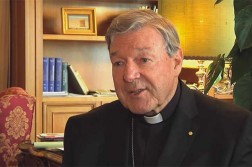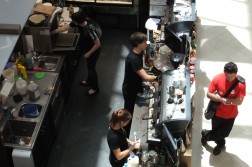Ever since it was invented in the early 1980s, the environment has been dear to the hearts of Australians everywhere, which is why it was so troubling to hear recently that it was in trouble.
The news, to be honest, sort of crept up on everybody. One minute we were enjoying our pristine, coal-fired modern utopia, and the next we were suddenly informed that "scientists" had dire warnings about an impending apocalypse. We were bombarded with terrifying prognostications. The ice caps would melt. Fiji would sink beneath the waves. Polar bears would no longer roam the Great Barrier Reef. Life as we know it would be over, replaced by life as we do not know it — a vague and unsettling thought.
It’s so different to what we were told as children. When I was a lad at school we were assured that as long as we didn’t litter and stopped using deodorants, everything would be "fine" thus proving that the current plague of lying communist teachers is not a new phenomenon.
These days it’s clear that plentiful bins and poor hygiene have not been enough to avert calamity, with lethal emissions spewing out of every car, air conditioner and oil refinery. Even the simple pleasure of a burping cow has become redolent with sinister significance.
So what’s the solution? "Cut emissions!" cry the green crowd, led by well-known broken record Bob Brown. But it’s not that simple, is it? There are competing interests to consider, alternatives to mull, consequences to foresee, environment ministers to sedate. It’s all very well to agree that emissions need to be cut, but once it gets to the nitty-gritty, suddenly everyone has a different point of view on how it should be done.
For example, one suggested solution is the "consume less" option. Under this scheme, emissions could be cut by people using less electricity, petrol, consumer goods etc, and adopting more modest lifestyles in order to lessen the strain on our environment. This is also known as the "ha ha ha" option. Less electricity? Sure! Why don’t we regress to medieval times? Why don’t we just sit around in the dark, listening to the sound of our own digestive tracts? That sounds like a blast. Less petrol? Oh, that’s practical, isn’t it? So what are we supposed to do? Ride horses? Walk? Oh wow, what a great future the environmentalists have prepared for us, sipping recycled sewage from hemp bottles as we ride our horses blindly around the streets in the dark until we finally crash into a wall and die in a screaming heap of equine panic.
So that’s one "green" solution — a dystopian nightmare ending with our species’ inevitable extinction. What are the other options? Well, there’s the "renewable energy sources" option. This involves deriving our power needs from less apocalyptic sources. This sounds like a wonderful solution, except that all the sources they come up with are stupid.
Solar power? Ever heard of something called "clouds", genius? Ever hear of something called "winter"? What’s more — and I looked this up — the sun is over 93 million miles away! To put that in understandable terms, if the sun were a lightbulb in China, the earth would be a basketball in Portugal. Does that sound like an efficient way to produce energy to you? Does it even make sense? Do we want to leave the fate of the world’s industries to such an incomprehensible analogy?
Other impractical solutions include wind, which is a great idea until the breeze dies down, the lights go out, and everyone ends up standing outside blowing as hard as they can, trying to catch the last five minutes of Lost. Then there’s hot rocks, which involves rocks being hot and thereby producing electricity. To see the absurdity of this proposal, one need only conduct a simple experiment: 1. Get a rock. 2. Put it in the microwave. Yeah. Call me when you’ve got baseload up and running.
So apart from lower consumption and renewables, what else is there? Well, there’s the "Earth Hour" solution, which involves turning your lights off for an hour every year. If everybody in Australia did this, it would be the equivalent of taking 10 cars off the road, only much more smug. The Earth Hour solution is not designed to end climate change per se, but rather to raise awareness of just how much we care. It’s sort of like global warming’s answer to the 40-Hour Famine, without the fund-raising or self-sacrificing or tangible results parts. So that’s a definite option for anyone with just a scrap of conscience, or who could do with a short nap.
Finally, of course, there’s the "Murdoch solution", as espoused by prominent climatologists such as Miranda Devine and Andrew Bolt. This solution proposes, radically, that we solve climate change by doing nothing, because:
— Climate change is not happening.
— If climate change is happening, it’s not our fault.
— If it is our fault, there’s nothing we can do about it unless China sinks into the ocean.
— Even if we could do something about it, we shouldn’t, because it’s actually good to be a bit warmer.
So one could say the Murdoch solution is the most comforting answer to the problem, and I actually endorse it as the solution most likely to give one a soothing sense of calm and general optimism. On the downside, if true, it would mean Miranda Devine was right, which is a shocking example to set for our children.
The Government, of course, has decided on none of these approaches. Rather, it has opted for an emissions trading scheme. This is not, as you may reasonably surmise, a scheme for trading emissions — under the scheme, you will not be able to swap a plume of barbecue smoke for a magnum of carbon monoxide — which is typical of Labor’s lack of imagination.
No, under the ETS, the Government will set a certain limit for greenhouse emissions, and produce a set number of emission permits up to that limit. Having set a starting price for the permits, it will then give them away free to any company that might need them, thus sending a strong message while maintaining the strength of the Australian economy. This is what scholars call "capitalism in action", and just goes to show what can be achieved when government sits down in good faith with business, green groups and other stakeholders to establish sound, workable, long-term tokenism.
Naturally, as with all boldly historic moves, the ETS has its critics: greenies say it doesn’t go far enough, but anything short of taxpayer-funded bongs and compulsory sodomy doesn’t go far enough for those scruffy "earth-lovers". Business says it goes too far, inasmuch as it does not transfer funds directly into executives’ bank accounts. The Opposition says it is a flagrant example of the Government making policy without regard for the Coalition’s feelings.
All of these criticisms are valid to a degree, but nothing is perfect: you can’t make an omelette without breaking eggs, and you can’t implement an emissions trading scheme without accepting that it will not actually achieve anything. That’s life, people. If you thought otherwise, maybe it’s time to take off your nappies, drop the teddy bear and join us here on planet reality. After all, isn’t an ineffective and pointless ETS better than no ETS at all?
I know it seems a little scary to think of rising sea levels, and scorching heat, and the downfall of civilisation, but you don’t have to be frightened. No matter how gloomy the scientists’ predictions get, there is one key fact worth remembering: seven million Australians are now overweight or obese, with that number expected to keep rising. So by the time the worst effects of climate change are felt, you will almost certainly have died from diabetes.
Which just proves there’s always a silver lining if you look hard enough.
Donate To New Matilda
New Matilda is a small, independent media outlet. We survive through reader contributions, and never losing a lawsuit. If you got something from this article, giving something back helps us to continue speaking truth to power. Every little bit counts.



